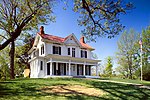Chair (sculpture)
1959 sculpturesAdvertisementsAluminum sculptures in Washington, D.C.ChairsOutdoor sculptures in Washington, D.C. ... and 2 more
Roadside attractions in Washington, D.C.Use mdy dates from February 2023

Chair is a public artwork designed as an advertisement by Bassett Furniture, located at the intersection of Martin Luther King Ave. and V. Street S.E., in the Anacostia neighborhood of Washington, D.C., United States. Chair was originally surveyed as part of the Smithsonian's Save Outdoor Sculpture! survey in 1994. It was once considered the world's largest chair, but has been overtaken by works like Broken Chair in Geneva and the temporary The Writer on Hampstead Heath in London.
Excerpt from the Wikipedia article Chair (sculpture) (License: CC BY-SA 3.0, Authors, Images).Chair (sculpture)
V Street Southeast, Washington Anacostia
Geographical coordinates (GPS) Address Nearby Places Show on map
Geographical coordinates (GPS)
| Latitude | Longitude |
|---|---|
| N 38.8654 ° | E -76.989705555556 ° |
Address
V Street Southeast
20020 Washington, Anacostia
District of Columbia, United States
Open on Google Maps






